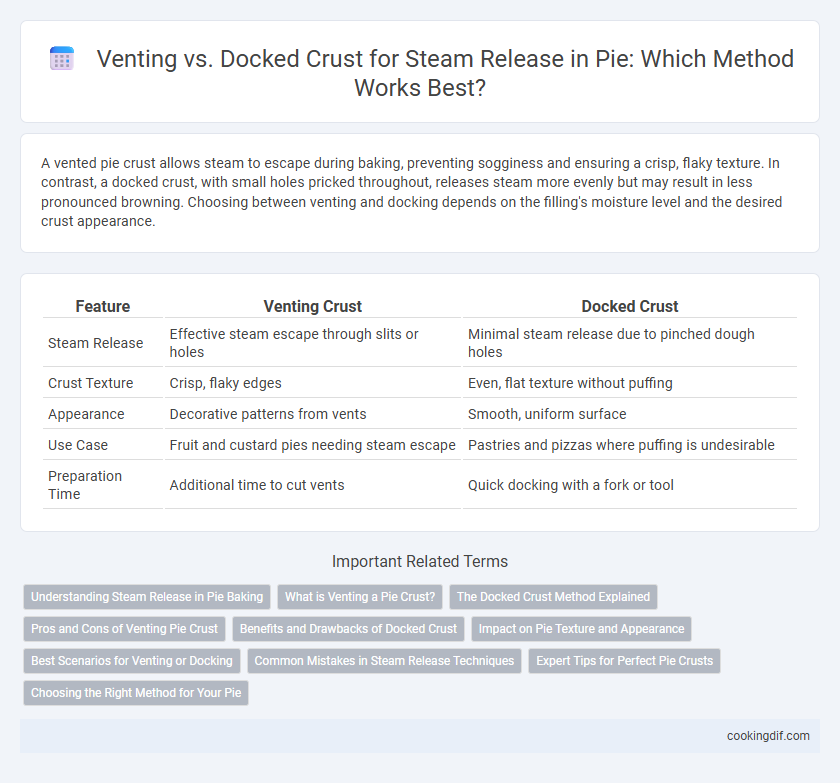A vented pie crust allows steam to escape during baking, preventing sogginess and ensuring a crisp, flaky texture. In contrast, a docked crust, with small holes pricked throughout, releases steam more evenly but may result in less pronounced browning. Choosing between venting and docking depends on the filling's moisture level and the desired crust appearance.
Table of Comparison
| Feature | Venting Crust | Docked Crust |
|---|---|---|
| Steam Release | Effective steam escape through slits or holes | Minimal steam release due to pinched dough holes |
| Crust Texture | Crisp, flaky edges | Even, flat texture without puffing |
| Appearance | Decorative patterns from vents | Smooth, uniform surface |
| Use Case | Fruit and custard pies needing steam escape | Pastries and pizzas where puffing is undesirable |
| Preparation Time | Additional time to cut vents | Quick docking with a fork or tool |
Understanding Steam Release in Pie Baking
Venting the crust in pie baking allows steam to escape, preventing soggy fillings and ensuring a crisp, flaky texture in the crust. Docked crusts, pierced with small holes, also promote steam release but in a more controlled manner, minimizing the risk of bubbling or cracking. Proper steam management in pie baking preserves the filling's consistency while maintaining the structural integrity of the crust.
What is Venting a Pie Crust?
Venting a pie crust involves cutting small slits or holes in the top crust to allow steam to escape during baking, preventing sogginess and ensuring a crisp texture. This technique helps maintain the pie's structural integrity by avoiding steam buildup that can cause bubbling or bursting. Compared to a docked crust, which is pricked uniformly to release air, venting creates specific openings that direct steam away from filling and crust edges.
The Docked Crust Method Explained
The docked crust method involves puncturing the pie crust with a fork or docking tool to create small holes that allow steam to escape during baking, preventing the crust from puffing up or cracking. This technique ensures even cooking and maintains a flat crust surface, ideal for pies with delicate fillings or those requiring blind baking. Using the docked crust method improves texture by releasing excess moisture without compromising the crust's structure or flavor.
Pros and Cons of Venting Pie Crust
Venting pie crusts allow steam to escape during baking, preventing soggy fillings and maintaining a flaky, crisp texture, which enhances the overall flavor and structural integrity of the pie. However, vented crusts may lead to a drier filling due to moisture loss and can sometimes cause the crust edges to brown unevenly. Choosing vented crusts suits fruit pies with high moisture content, while less venting is preferred for custards or cream pies to retain smoothness and moisture.
Benefits and Drawbacks of Docked Crust
Docked crust in pie baking allows steam to escape through small punctures, preventing bubbling and ensuring an even, flat surface ideal for decorative toppings. This technique reduces the risk of sogginess by promoting moisture evaporation but can lead to a less visually appealing crust compared to vented designs that incorporate deliberate slits or holes. While docking offers precise steam control, it may slightly compromise the crust's structural integrity and golden texture.
Impact on Pie Texture and Appearance
Venting pie crust allows steam to escape during baking, preventing sogginess and promoting a flaky, crisp texture, while docked crusts with small holes reduce steaming but may result in a denser, less flaky crust. Proper venting preserves the pie's golden-brown appearance by avoiding bubbling or cracking caused by trapped steam. Choosing between vented and docked crusts directly impacts the moisture balance, texture crispness, and visual appeal of the finished pie.
Best Scenarios for Venting or Docking
Venting pie crusts is ideal for fruit pies with high moisture content, such as cherry or blueberry, allowing steam to escape and preventing soggy bottoms while maintaining a golden, crisp texture. Docking is best suited for cream or custard pies where steam buildup is minimal, ensuring an even, flat crust that supports delicate fillings without collapsing. Choosing between venting and docking depends on the pie type, moisture level, and desired crust texture to optimize baking results.
Common Mistakes in Steam Release Techniques
A common mistake in steam release techniques for pie crusts is failing to vent properly, which causes the crust to become soggy or rise unevenly. Docking the crust with evenly spaced holes allows steam to escape, preventing air pockets and ensuring a crisp, golden finish. Over-docking, however, can result in excessive moisture loss, leading to a dry and crumbly texture.
Expert Tips for Perfect Pie Crusts
Venting a pie crust allows steam to escape during baking, preventing soggy fillings and ensuring a flaky texture. Expert bakers recommend cutting precise slits or using decorative cutouts on the dough to balance steam release while maintaining an attractive appearance. Docked crusts, created by pricking holes with a fork, are ideal for blind baking as they help avoid air pockets without compromising structural integrity.
Choosing the Right Method for Your Pie
Choosing between venting and docked crusts for steam release significantly impacts pie texture and flavor. Venting creates steam escape pathways, preventing sogginess, ideal for fruit pies with juicy fillings. Docked crusts use tiny punctures across the surface to evenly release steam, perfect for savory pies requiring a firmer, crisp crust.
Venting vs docked crust for steam release Infographic

 cookingdif.com
cookingdif.com